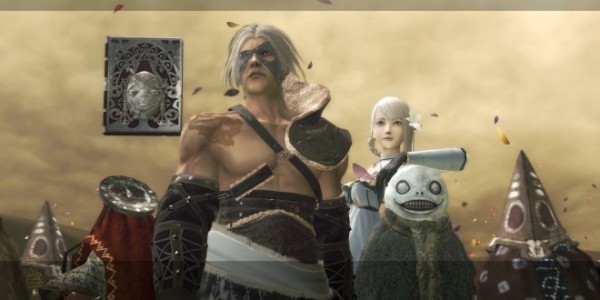Nier is a game primarily about loss, pain, and suffering; ironically, it is also a breath of fresh air. This multi-genre adventure by Cavia may struggle to nail down mechanical grace, but survives and shines on the quality of its writing — its characters, commentary, and the heavy themes it lays on players — making it a surprisingly original and enjoyable experience, and the best thing to come out of Square-Enix in 2010, besting even the publisher’s flagship franchise, Final Fantasy.
Nier is put together like a Frankenstien project; at first glance, the game most resembles a Japanese RPG, but later reveals itself to be an action-adventure with RPG and shooter elements that doesn’t shy away from occasionally experimenting with other genres. From bullet-hell shooting, to isometric dungeon-crawling, to a Resident Evil parody complete with a mansion, laboratory, themed doors and keys, and a grand piano, Nier aims and succeeds at diversifying play. There are even a few sections where the game turns to text-only interaction, presenting players with interesting and descriptive narrative and dialogue, punctuated by questions and answers requiring proper comprehension of the segment in order to proceed. Most of these play-style switches are total surprises, very refreshing, and most welcome.

Where players may find reason to complain about Nier is in the basic mechanics of combat and navigation; controlling protagonist Nier can be clumsy and touchy, leading players to misdirect sword strikes and magic blasts, or run/roll in directions other than intended. The camera, too, requires a bit of babysitting throughout the adventure, but is most disagreeable when semi-locked onto an element of the on-screen action, limiting the control to which the rest of the game accustoms players. Boss fights are sometimes guilty of this, and a few become challenging enough to make the game’s difficulty seem unusually spiky. This may be a result of the excessive reliance on shooting (magic) during boss fights, which wears out its welcome in what are otherwise epic, lengthy, spectacular boss encounters of tangible gravity.
While a very linear game, often providing a fat, red X on the map to indicate exactly where to go next, Nier also serves up a bevy of completely optional sidequests. These range from very simple to tedious and convoluted, and may yield cash rewards that are tiny, monumental, or anywhere in between. Were it not for the highly satisfying side-narrative payoff delivered via many of these quests, completely disregarding their existence would not be unimaginable. The game actually acknowledges the silliness of modern game design in this area, writing in non-player characters who greet Nier with comments like, “You’re that guy who does whatever people ask him to, right?” or “You’re that desperate guy who’ll take any job that comes along, no matter how stupid or demeaning.” The developers at Cavia clearly understand the role of sidequests, and have sculpted Nier‘s to specification.

Most importantly, however, Nier is built upon its narrative themes and characters. Throughout the adventure, players are forced to deal with loss and other forms of suffering. It is an emotional tale with flawed, weak, and struggling characters: Nier’s entire existence is devoted to finding a way to cure his daughter of a presumably deadly disease, supporting character Kaine has lived with ridicule her entire life, hardening her exterior while leaving her tormented inside, and companion Emil’s childhood has been ripped away from him, leaving him emotionally fragile and at least once consumed by “madness driven by hate.” Yonah, Nier’s daughter, struggles not only with her disease, but with emotional pain, as well: “Don’t hate me for this,” she expresses to her father as she watches him work tirelessly toward her recovery.
Nier never tiptoes around death. Different characters throughout the game lose a mother, brother, sister, son, wife, grandmother, dog, master, friends, and entire families. One entire town is obliterated, and even a few more central and important characters are lost, either as victims or through sacrifice. This game is not a light one, and players are made to feel the tale’s near hopeless ambiance and emotional impact in steady waves throughout. Perhaps most affective is the endgame, which challenges players’ understanding of the world they’ve spent roughly 25 hours in, forcing them to rethink their perspectives on right and wrong or good and evil, and inducing an unexpected and possibly resistant sense of compassion for certain characters. It’s here that the game can floor players, and it is an absolutely gratifying resolution to the narrative.
Nier won’t wow players with its basic mechanics, although its diversity of play is something to enjoy, but in the story it tells, the characters it develops, and the themes present throughout play, it will easily win over anyone seeking something emotionally exploratory and well off the beaten path. By the time the experience culminates, the many small complaints about the journey will have been all but forgotten.


















